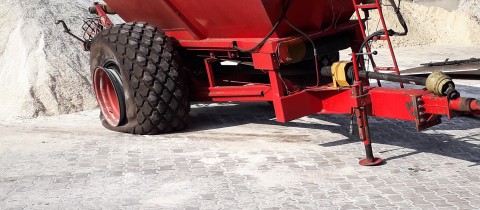7 Reasons for premature tyre wear and tear
You want your tyres to last as long as possible. After all, this will offer you the lowest price per kilometre and the highest return on your investment. So make sure your tyres do not suffer premature wear and tear. Continue reading to see how the wear pattern can be used to identify the potential problem.
1 – Tyre pressure too low
Both shoulders of the tyre will show signs of wear if you drive with insufficient tyre pressure for an extended period of time. This happens because pressure placed on the tread is not distributed equally. But there is a solution: make sure the tyre pressure is exactly right.
2 – Tyre pressure too high
But the opposite also applies: the centre of the tread can show signs of wear if the pressure in your tyres is too high. But, once again, there is a solution: make sure the tyre pressure is exactly right.
3 – Poor shock absorbers
If the ridges of the tyre are badly deformed, or if the tyre has regular areas of wear across its entire length, then there is a good chance that the shock absorbers do not work properly. Such damage can also be encountered if the wheel is not properly balanced and if there is play in suspension rubbers or steering ball joints. So check these points in order to resolve the problem.
4 – Incorrect wheel position
If the wheel is not correctly positioned, this can result in camber-related damage as well as tyre wear and tear due to improper alignment. This can easily be felt by hand. The problem can be resolved via realignment.
5 – Heel damage
The aim of the heel is to make sure the tyre and wheel connect to each other effectively, so air cannot escape. As soon as even the slightest bit of damage occurs on the heel, it must be replaced in the interest of safety. Heel damage often occurs because the mounting head has not been properly configured or because the heel has not been properly pressed into the rim bed.
6 – Side-wall wear
Curbstones are the worst enemy of side-walls. Damage caused by curbstones is easy to recognise. In principle, such wear and tear is not dangerous, as long as threads in the casing are not exposed or ripped. Wear and tear on side-walls can also be caused by collisions. So check if the tyre is not too big for the vehicle and if the wheel is in the correct position. Finally, the side-wall can also tear if it has been dehydrated by sunlight. You will need new tyres if such tears reach the threads in the casing.
7 – Saw-tooth damage
Saw-tooth damage can be encountered on non-driven axles. It is caused by low tyre pressure and poor alignment. This specific type of wear can be witnessed around the whole tyre circumference, and often across the full length of the tread. This wear can be felt by hand. Saw-tooth damage can be avoided by switching wheel positions on a regular basis.
Like to know more?
Do you need advice? Please contact us, our experts will be pleased to assist you. Contact our experts at +31 (0)523 - 850 850 or by e-mail to info@heuver.com. You can read all of our articles on our knowledge-page.

